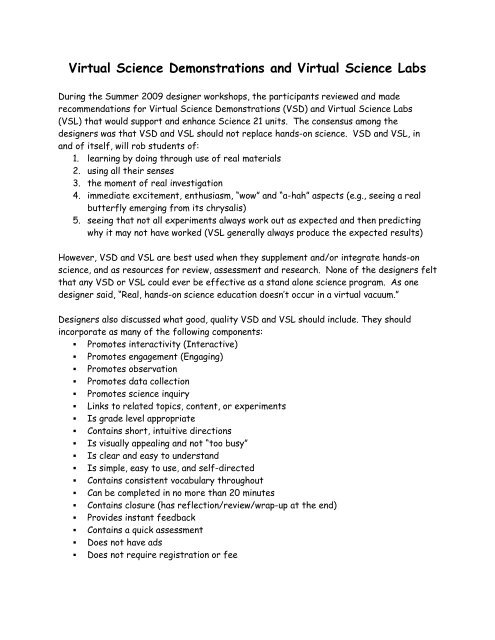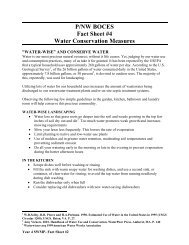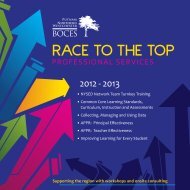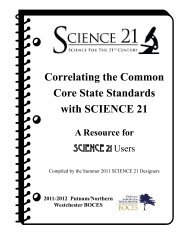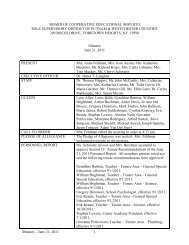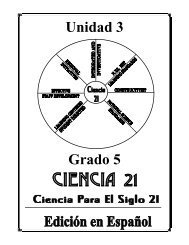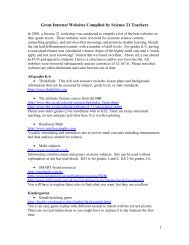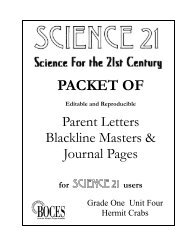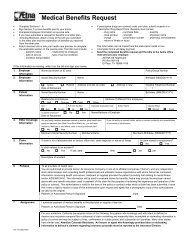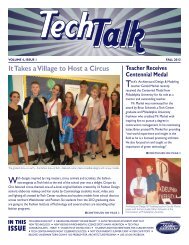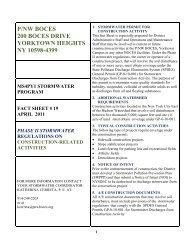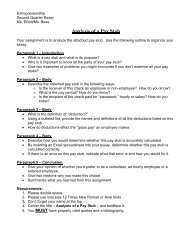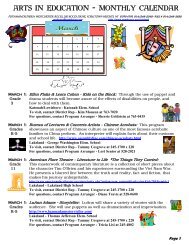Virtual Science Demonstrations and Virtual Science Labs - Boces
Virtual Science Demonstrations and Virtual Science Labs - Boces
Virtual Science Demonstrations and Virtual Science Labs - Boces
You also want an ePaper? Increase the reach of your titles
YUMPU automatically turns print PDFs into web optimized ePapers that Google loves.
<strong>Virtual</strong> <strong>Science</strong> <strong>Demonstrations</strong> <strong>and</strong> <strong>Virtual</strong> <strong>Science</strong> <strong>Labs</strong><br />
During the Summer 2009 designer workshops, the participants reviewed <strong>and</strong> made<br />
recommendations for <strong>Virtual</strong> <strong>Science</strong> <strong>Demonstrations</strong> (VSD) <strong>and</strong> <strong>Virtual</strong> <strong>Science</strong> <strong>Labs</strong><br />
(VSL) that would support <strong>and</strong> enhance <strong>Science</strong> 21 units. The consensus among the<br />
designers was that VSD <strong>and</strong> VSL should not replace h<strong>and</strong>s-on science. VSD <strong>and</strong> VSL, in<br />
<strong>and</strong> of itself, will rob students of:<br />
1. learning by doing through use of real materials<br />
2. using all their senses<br />
3. the moment of real investigation<br />
4. immediate excitement, enthusiasm, “wow” <strong>and</strong> “a-hah” aspects (e.g., seeing a real<br />
butterfly emerging from its chrysalis)<br />
5. seeing that not all experiments always work out as expected <strong>and</strong> then predicting<br />
why it may not have worked (VSL generally always produce the expected results)<br />
However, VSD <strong>and</strong> VSL are best used when they supplement <strong>and</strong>/or integrate h<strong>and</strong>s-on<br />
science, <strong>and</strong> as resources for review, assessment <strong>and</strong> research. None of the designers felt<br />
that any VSD or VSL could ever be effective as a st<strong>and</strong> alone science program. As one<br />
designer said, “Real, h<strong>and</strong>s-on science education doesn’t occur in a virtual vacuum.”<br />
Designers also discussed what good, quality VSD <strong>and</strong> VSL should include. They should<br />
incorporate as many of the following components:<br />
• Promotes interactivity (Interactive)<br />
• Promotes engagement (Engaging)<br />
• Promotes observation<br />
• Promotes data collection<br />
• Promotes science inquiry<br />
• Links to related topics, content, or experiments<br />
• Is grade level appropriate<br />
• Contains short, intuitive directions<br />
• Is visually appealing <strong>and</strong> not “too busy”<br />
• Is clear <strong>and</strong> easy to underst<strong>and</strong><br />
• Is simple, easy to use, <strong>and</strong> self-directed<br />
• Contains consistent vocabulary throughout<br />
• Can be completed in no more than 20 minutes<br />
• Contains closure (has reflection/review/wrap-up at the end)<br />
• Provides instant feedback<br />
• Contains a quick assessment<br />
• Does not have ads<br />
• Does not require registration or fee
We are indebted to the leadership of <strong>Science</strong> 21 Consultants, Kent Leo (Grades 2-4)<br />
<strong>and</strong> Rick Reuschle (Grades 5-6) as the participants explored, evaluated, <strong>and</strong><br />
recommended virtual demonstrations <strong>and</strong> labs <strong>and</strong> also, of course, to the designers<br />
listed below:<br />
Participant Name Grade School District School<br />
DANIELLE COLETTA 3 YORKTOWN BROOKSIDE ELEM.<br />
SCOTT FRIDKIN 3 OSSINING BROOKSIDE<br />
EILEEN LYNCH 3 LAKELAND LINCOLN TITUS<br />
GINNY MUNOZ 3 CHAPPAQUA WESTORCHARD<br />
MIJECHELE PURPURA 3 YORKTOWN BROOKSIDE<br />
JOY SNYDER 3 WAPPINGERS MYERS CORNERS<br />
KATIE MOELLER 3 HALDANE HALDANE ELEM.<br />
The recommendations are shown below organized according to Grade Level <strong>and</strong> Unit.<br />
General Disclaimer: Such websites are occasionally changed or may not be<br />
available when teachers <strong>and</strong>/or students visit them. Also, although the workshop<br />
participants examined each of the websites/labs/demonstrations, not all aspects<br />
of them were vetted for appropriateness, accuracy, <strong>and</strong> consistency with our<br />
curriculum.<br />
GRADE THREE<br />
Suggested <strong>Virtual</strong> <strong>Science</strong> <strong>Demonstrations</strong> <strong>and</strong> <strong>Virtual</strong> <strong>Science</strong> <strong>Labs</strong><br />
Unit 1<br />
http://www.bbc.co.uk/schools/ks2bitesize/science/activities/plants_grow.shtml<br />
This interactive site explores conditions that can affect plant growth. (Interactive<br />
Lab)<br />
http://www.explorelearning.com/index.cfm?method=cResource.dspResourcesForCo<br />
urse&CourseID=355 Click on “Growing Plants” or “Germination.” Both of these<br />
games go along with Unit 1. “Germination” goes right along with the lesson on what<br />
makes a seed germinate. “Growing Plants” can be used as a culminating activity or<br />
as review. With both games the students have 3 sets to experiment with.<br />
Students get to choose the seeds, heat, water, etc. They will then see what will<br />
grow (or germinate) <strong>and</strong> what won’t. (Lab <strong>and</strong> Interactive Resource)
http://www.teachersdomain.org/resource/tdc02.sci.life.colt.lp_plantcycle/<br />
Plant Videos – discusses how plants grow, germinate <strong>and</strong> how to plant a “seed sock”<br />
– nice demonstrations of what students can do. (Demonstration/Resource)<br />
http://www.discoveryeducation.com/products/science/elementary.cfm<br />
Scroll down to “Interactive Glossary,” <strong>and</strong> click on it. This can be used for Unit 1<br />
with the germination lesson <strong>and</strong> lessons on parts of a flower. These are<br />
demonstrations, but simplified enough for students to underst<strong>and</strong>. You can link on<br />
animation for an animated picture that moves <strong>and</strong> labels parts. There is also a<br />
video with information. (Demonstration/Resource)<br />
http://www.teachersdomain.org/resource/lsps07.sci.life.oate.plantparts/ An<br />
interactive site that teaches about plant parts. (Interactive Resource)<br />
http://www.bbc.co.uk/schools/ks2bitesize/science/activities/life_cycles.shtml<br />
This site is an activity related to the structure of the flower. (Interactive<br />
Resource)<br />
http://urbanext.illinois.edu/gpe/index.html An interactive site to help students<br />
learn about plant growth, plant parts <strong>and</strong> the plant cycle. (Interactive Resource)<br />
http://www.naturegrid.org.uk/plant/index.html “Plant Explorer” helps students to<br />
learn about various aspects of the plant. (Interactive Resource)<br />
http://www.ngflcymru.org.uk/vtc/20050225/<strong>Science</strong>/Keystage2/thinkings/partso<br />
fap/introduct/Starteractivity.htm This is an interactive resource to learn about<br />
plant parts <strong>and</strong> their functions. (Interactive Resource)<br />
http://www.crickweb.co.uk/assets/resources/flash.php?&file=lcycles5b An<br />
interactive resource for the study of the plant life cycle. (Interactive Resource)<br />
http://www.catie.org.uk/plants_galore_page.html An interactive resource for the<br />
study of the plant life cycle. (Interactive Resource)<br />
http://www.harcourtschool.com/activity/science_up_close/515/deploy/interface.h<br />
tml This site is a wonderful teaching tool for teaching the parts of a flower for<br />
lesson 5. It has audio <strong>and</strong> real photographs explaining the parts of the flower <strong>and</strong><br />
showing different examples of each part. (Resource)
http://www.harcourtschool.com/activity/science_up_close/512/deploy/interface.h<br />
tml This site is a wonderful teaching tool for teaching photosynthesis. It has<br />
audio <strong>and</strong> animated video clips, showing the entire process. (Resource)<br />
http://www.teachersdomain.org/resource/lsps07.sci.life.reg.plantmovies/ Plant<br />
Video on how plants move <strong>and</strong> grow in response to light. (Resource)<br />
http://www.mbgnet.net/bioplants/main.html This site is a resource for plant<br />
growth <strong>and</strong> plant parts. (Resource)<br />
Unit 2<br />
http://www.bbc.co.uk/schools/scienceclips/ages/6_7/electricity.shtml Simple<br />
experiment to find out which objects conduct electricity. (Lab)<br />
http://www.bbc.co.uk/schools/ks2bitesize/science/activities/conductors.shtml<br />
Experiment on electrical conductivity. (Lab)<br />
http://www.bbc.co.uk/schools/scienceclips/ages/10_11/changing_circuits.shtml<br />
Experiments dealing with circuits. (Lab)<br />
http://www.bbc.co.uk/schools/podsmission/electricity/annie02.shtml This is a<br />
virtual circuit builder. (Lab)<br />
http://199.6.131.12/en/scictr/lab/relax/index.htm Electromagnet experiment<br />
(Lab)<br />
http://www.<strong>and</strong>ythelwell.com/blobz/guide.html Building Circuits-Interactive (Lab<br />
<strong>and</strong> Interactive Resource)<br />
http://www.teachersdomain.org/resource/phy03.sci.phys.mfe.zele/ Zoom video<br />
demonstration on how to show static electricity, using an electroscope.<br />
(Demonstration)<br />
http://www.bbc.co.uk/schools/ks2bitesize/science/activities/conductors.shtml<br />
Circuits <strong>and</strong> conductors (Interactive Resource)
http://www.explorelearning.com/index.cfm?method=cResource.dspResourcesForCo<br />
urse&CourseID=360 Click on “Circuit Builder.” This can be used along with Unit 2<br />
either as a culminating lesson or an introductory lesson. This is a simple game<br />
where the students must drag materials over to make a circuit. There is a student<br />
worksheet to go along with the game <strong>and</strong> a vocabulary sheet. (Interactive<br />
Resource)<br />
http://www.energyquest.ca.gov/ This is an “energy quest” that is a great resource,<br />
which contains video clips, factual information <strong>and</strong> interactive searches.<br />
(Interactive Resource)<br />
http://www.engineeringinteract.org/resources/siliconspies/siliconspieslink.htm<br />
Interactive game dealing with electricity, <strong>and</strong> includes interesting facts on<br />
electricity <strong>and</strong> circuits. (Interactive Resource)<br />
http://www.centralhudson.com/Kids/electric/html/kids1.html Electricity <strong>and</strong><br />
insulators/conductors. (Resource)<br />
http://invention.smithsonian.org/centerpieces/edison/ Thomas Edison (Resource)<br />
http://www.miamisci.org/af/sln/frankenstein/safety.html Electrical Safety<br />
(Resource)<br />
Unit 3<br />
http://www.teachersdomain.org/resource/ess05.sci.ess.watcyc.hydrocycle/ An<br />
animated demonstration of the water cycle. Individual stages are animated as<br />
well. (Demonstration)<br />
http://www.epa.gov/safewater/kids/games<strong>and</strong>activies.html Site contains<br />
interactive games <strong>and</strong> information on the water cycle, water treatment <strong>and</strong> other<br />
interesting water facts. (Interactive Resource)<br />
http://apps.southeastwater.com.au/games/education_kidsroom_wcactivity.asp<br />
Water Cycle Activity (Interactive Resource)<br />
http://www.eo.ucar.edu/webweather/cloudhome.html Clouds & Weather<br />
(Interactive Resource)
http://eo.ucar.edu/webweather/cloud3.html Cloud types with matching <strong>and</strong><br />
concentration game. (Interactive Resource)<br />
www.teacher.scholastic.com/activities/studyjams/water_cycle/ This contains a<br />
good 3 minute video about the water cycle <strong>and</strong> states of matter. It also contains a<br />
teacher guide <strong>and</strong> lesson plan. (Resource)<br />
http://www.epa.gov/OGWDW/kids/flash/flash_watercycle.html Water Cycle<br />
(Resource)<br />
http://www.abpischools.org.uk/page/modules/solids-liquidsgases/?coSiteNavigation_allTopic=1<br />
Video on States of Matter (Resource)<br />
Unit 4<br />
http://www.bgfl.org/bgfl/custom/resources_ftp/client_ftp/ks1/science/hamshall<br />
/life_cycles/index.htm This site is a resource for the Butterfly Life Cycle.<br />
(Resource)<br />
The following list of websites, SMARTBoard lessons, <strong>and</strong> interactive<br />
was developed by Scott Fridkin, a third grade teacher at Claremont<br />
School in Ossining.<br />
Third Grade <strong>Science</strong> SMARTBoard Lessons/ Interactives:<br />
Plants:<br />
General<br />
http://www.topmarks.co.uk/Interactive.aspx?cat=78<br />
http://urbanext.illinois.edu/gpe/index.html<br />
Photosynthesis: http://www.kscience.co.uk/animations/photosynthesis.htm<br />
http://www.harcourtschool.com/activity/science_up_close/311/deploy/interface.html<br />
Structure of a leaf: http://www.curriculumbits.com/prodimages/details/biology/bio0017.html<br />
http://www.curriculumbits.com/prodimages/details/biology/bio0021.html
Biology of Plants from seeds to flowers:<br />
http://www.mbgnet.net/bioplants/main.html<br />
Plant Life Cycle:<br />
http://www.ngfl-cymru.org.uk/vtc/plant_life_cycles/eng/Introduct/default.htm<br />
Parts of a Flower:<br />
http://www.harcourtschool.com/activity/science_up_close/213/deploy/interface.html<br />
http://www.inlets.net/ICT/science/plants/index.php#<br />
http://www.bbc.co.uk/schools/ks2bitesize/science/activities/life_cycles.shtml<br />
Roots:<br />
http://education.smarttech.com/ste/en-<br />
US/Ed+Resource/Lesson+activities/Senteo/USA/Elementary/K-<br />
3/<strong>Science</strong>/Roots+<strong>and</strong>+Leaves+Question+set.htm<br />
http://www.scholastic.com/play/root.htm<br />
Pollination:<br />
http://www.ngfl-cymru.org.uk/vtc/plant_repro/eng/Introduction/default.htm<br />
http://www.explorelearning.com/index.cfm?method=cResource.dspView&ResourceID=635<br />
What affects plant growth:<br />
http://www.ngfl-cymru.org.uk/vtc/factors_plant_growth/eng/Introduction/default.htm<br />
http://www.bbc.co.uk/schools/ks2bitesize/science/activities/plants_grow.shtml<br />
http://www.bbc.co.uk/schools/scienceclips/ages/5_6/growing_plants.shtml<br />
http://www.ngfl-cymru.org.uk/vtc/plants_light_water_to_grow/eng/Introduction/default.htm<br />
http://www.education.smarttech.com/ste/en-<br />
US/Ed+Resource/Lesson+activities/Notebook+Activities/Browse+Notebook/Canada/Elementary<br />
/K-3/<strong>Science</strong>/Plant+Needs.htm
http://www.explorelearning.com/index.cfm?method=cResource.dspView&ResourceID=615<br />
http://www.explorelearning.com/index.cfm?method=cResource.dspView&ResourceID=637<br />
Plant or animal?<br />
http://www.foodafactoflife.org.uk/Activity.aspx?siteId=13§ionId=54&contentId=173<br />
Labeling a green plant:<br />
http://www.education.smarttech.com/ste/en-<br />
US/Ed+Resource/Lesson+activities/Notebook+Activities/Browse+Notebook/Canada/Elementary<br />
/K-3/<strong>Science</strong>/Labeling+a+Green+Plant.htm<br />
Trees:<br />
http://urbanext.illinois.edu/trees1/flash/index.html<br />
http://urbanext.illinois.edu/trees2/index2.html<br />
Plant Quiz:<br />
http://www.woodl<strong>and</strong>s-junior.kent.sch.uk/revision/<strong>Science</strong>/plantparts.html#quiz<br />
Electricity:<br />
Electrical Safety: http://www.switchedonkids.org.uk/<br />
http://www.derbyshire-fire-service.co.uk/userimages/kitchen.swf<br />
Circuits:<br />
http://www.learningcircuits.co.uk/<br />
http://www.mystery-productions.info/hyper/Hypermedia_2003/Thelwell/Site/<br />
http://www.bbc.co.uk/schools/ks2bitesize/science/activities/changing_circuits.shtml<br />
http://www.explorelearning.com/index.cfm?method=cResource.dspView&ResourceID=638<br />
http://www.bbc.co.uk/schools/scienceclips/ages/6_7/electricity.shtml<br />
Conductors <strong>and</strong> non-conductors:<br />
http://www.bbc.co.uk/schools/ks2bitesize/science/activities/conductors.shtml<br />
Batteries:
http://education.smarttech.com/ste/en-<br />
GB/Ed+Resource/Lesson+Activities/Notebook+Activities/Browse+Notebook/Secondary/KS3/Sc<br />
ience/Batteries.htm<br />
Different forms of energy:<br />
http://www.bmweducation.co.uk/energised/<br />
http://www.sciencenetlinks.com/interactives/powerup.html<br />
Water Cycle:<br />
http://www.southeastwater.co.uk/education/watercycle.asp<br />
http://www.education.smarttech.com/ste/en-<br />
US/Ed+Resource/Lesson+activities/Notebook+Activities/Browse+Notebook/United+States/Ele<br />
mentary/4-6/<strong>Science</strong>/The+Water+Cycle.htm<br />
http://www.bbc.co.uk/schools/rivers<strong>and</strong>coasts/water_cycle/rivers/pg_02_flash.shtml<br />
Cleaning Dirty Water (movie)<br />
http://www.primaryscience.ie/site/activities_activity_movies.php<br />
Solids <strong>and</strong> Liquids:<br />
http://www.bbc.co.uk/schools/ks2bitesize/science/activities/solids_liquids.shtml<br />
http://www.education.smarttech.com/ste/en-<br />
US/Ed+Resource/Lesson+activities/Notebook+Activities/Browse+Notebook/United+States/Ele<br />
mentary/K-3/<strong>Science</strong>/Water+Liquid+or+Solid+SMARTcreated.htm<br />
http://www.education.smarttech.com/ste/en-<br />
US/Ed+Resource/Lesson+activities/Notebook+Activities/Browse+Notebook/Canada/Elementary<br />
/4-6/<strong>Science</strong>/Solids+Liquids+<strong>and</strong>+Gasses.htm<br />
http://www.bbc.co.uk/schools/scienceclips/ages/8_9/solid_liquids.shtml<br />
States of matter:<br />
http://www.bbc.co.uk/schools/ks2bitesize/science/activities/gases.shtml<br />
http://www.bbc.co.uk/schools/ks2bitesize/science/activities/changing_state.shtml
http://www.abpischools.org.uk/page/modules/solids-liquids-gases/<br />
http://www.explorelearning.com/index.cfm?method=cResource.dspView&ResourceID=661<br />
Evaporation:<br />
http://www.education.smarttech.com/ste/en-<br />
US/Ed+Resource/Lesson+activities/Notebook+Activities/Browse+Notebook/United+States/Ele<br />
mentary/K-3/<strong>Science</strong>/Water++Evaporation+SMARTcreated.htm<br />
http://www.fossweb.com/modules3-6/Water/activities/evaporation.html<br />
Weather:<br />
http://www.education.smarttech.com/ste/en-<br />
US/Ed+Resource/Lesson+activities/Notebook+Activities/Browse+Notebook/Canada/Elementary<br />
/K-3/<strong>Science</strong>/Weather.htm<br />
http://www.education.smarttech.com/ste/en-<br />
US/Ed+Resource/Lesson+activities/Notebook+Activities/Browse+Notebook/Canada/Elementary<br />
/K-3/<strong>Science</strong>/Whats+the+Weather.htm<br />
http://urbanext.illinois.edu/kalani/<br />
Temperature:<br />
http://education.smarttech.com/ste/en-<br />
US/Ed+Resource/Lesson+activities/Senteo/USA/Elementary/K-<br />
3/<strong>Science</strong>/What+Is+the+Temperature+Question+set.htm<br />
Butterflies:<br />
What is an insect:<br />
http://www.ngfl-cymru.org.uk/vtc/minbeasts/eng/Introduction/default.htm<br />
http://urbanext.illinois.edu/insects/<br />
Life Cycle:<br />
http://www.ngfl-cymru.org.uk/vtc/2008-09/cynnal/discovery/eng/life_cycle_3.html<br />
Metamorphosis:
http://www.harcourtschool.com/activity/science_up_close/315/deploy/interface.html<br />
Camouflage:<br />
http://oncampus.richmond.edu/academics/education/projects/webunits/adaptations/camou1.html<br />
http://www.butterfly-guide.co.uk/survival/cam_early.htm<br />
General All Subjects:<br />
http://technology.usd259.org/resources/whiteboards/smartlessons/elementary_lessons.html#Sci<br />
http://www.internet4classrooms.com/skills_3rd_original.htm<br />
http://www.longwood.k12.ny.us/longsmart_elem.html<br />
http://www.smartboardlounge.com/<br />
N:\<strong>Science</strong> 21\Misc\<strong>Virtual</strong> <strong>Labs</strong> <strong>and</strong> Demos\<strong>Virtual</strong> <strong>Labs</strong> <strong>and</strong> Demos Grade 3.doc


